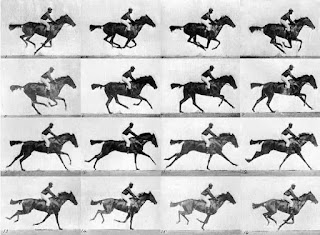Review of Nope in Prep for Candyman
We saw Nope at the Princeton Garden Theater, and, probably because I recently watched Jordan Peele's Get Out and Us, I sat at the edge of my seat, ready to interpret and understand the threads that would tie all of these pieces together. But the pieces didn't quite go together; at least not in the way I thought they would.
The film opens with a scene of carnage on a sitcom where the chimpanzee has gone beserk and killed or maimed many of the actors on the set. The chimp will return, most notably in a scene where he fist bumps to the child actor who survives. I didn't get it. I still don't get it. At least not in relation to any of the racial themes we've been discussing in class. Unless it connects back to the horses--who also figure largely in this movie because the main character, OJ Haywood, is an owner of a ranch that lets out its horses for Hollywood films. His great grandfather was the first human figure in the original first ever recorded film (this is fictional, but it works). The movie itself is broken up into sections that are named for the horses they own: Ghost, Clover, Gordy (this is the exception--Gordy is the name of the chimp), Lucky, and Jean Jacket. Screenrant has an excellent break down of the film here.
As we were walking out of the film, I was quickly trying to theorize what all of it mean (the last twenty minutes were a bit confusing to me--I understood they were trying to capture the alien force, but I did not quite get what their plan was for luring it toward something--it also had something to do with the electric grid and a giant big boy like floatie from the Western World. These were my quick theories, none of which has panned out in any discussion of the film so far:
1. The film is about how slavery impacted Black lives, and how it still impacts Black lives by making the Haywood's marginalized in Hollywood--invisible still, as their great grandfather was invisible. Slaves were once seen as no better than animals or horses--their function was to perform and work, so there is a close relationship between the Haywood's and their horses who are almost like family.
2. In old style Westerns, the good guy wears black, rides a white horse. In this film, the white horse (Ghost) is the first to go, and the good guy here not only is a Black man, but he's a Black man who rides a black horse named Lucky. In this way, the movie is against the typical Western cinema trope.
3. The Haywoods defeat the alien in the sky by not looking directly at him. I thought this might have been in reference to how Black bodies in earlier times and today have to behave deferentially to others in order (whites) to survive, particularly in a situation when the police are involved. By not staring at the creature and feigning deference, they are actual able to defeat it.
4. The alien in the sky represents all of the intangible anxiety we feel now after Trump, after COVID, after climate change, after all the shit that's been going on. America is changed forever. We are more divided and afraid than we ever have been and we're fighting this amorphous "thing" that threatens our lives.
5. It's a critique of reality TV and this thirst for being discovered or scene. Part of the film is about trying to capture an image of the alien to get "Oprah famous." Because this film is set near Hollywood and because one of the main characters is a former child star, there is a sense that everyone in the film is hoping to make it big somehow. We're filming every aspect of our lives on Tik Tok and Instagram, hoping to go viral.
But then of course I did some reading and none of the reviewers mentioned any of this stuff, they were all like, It's about modern cinema.

Comments